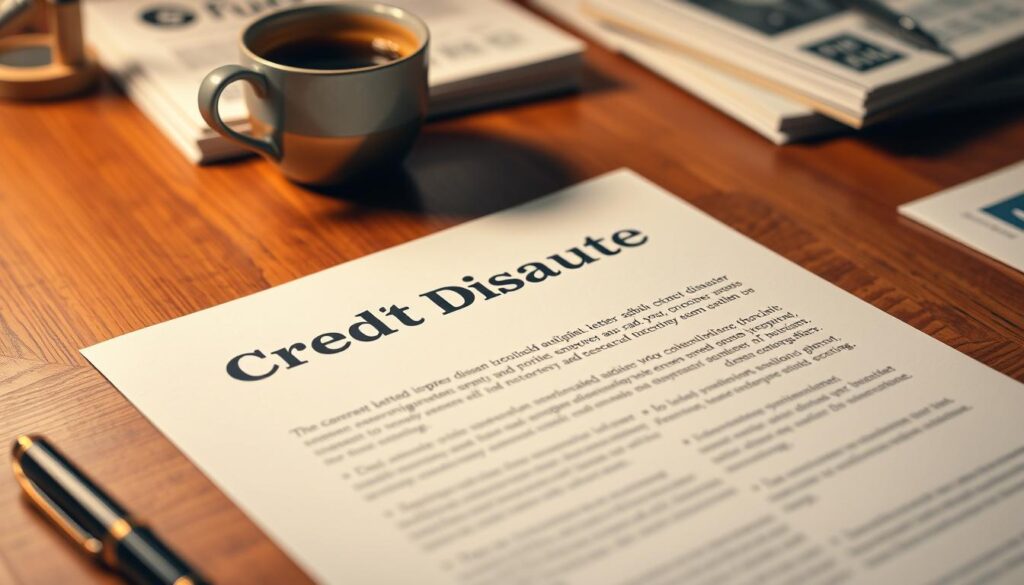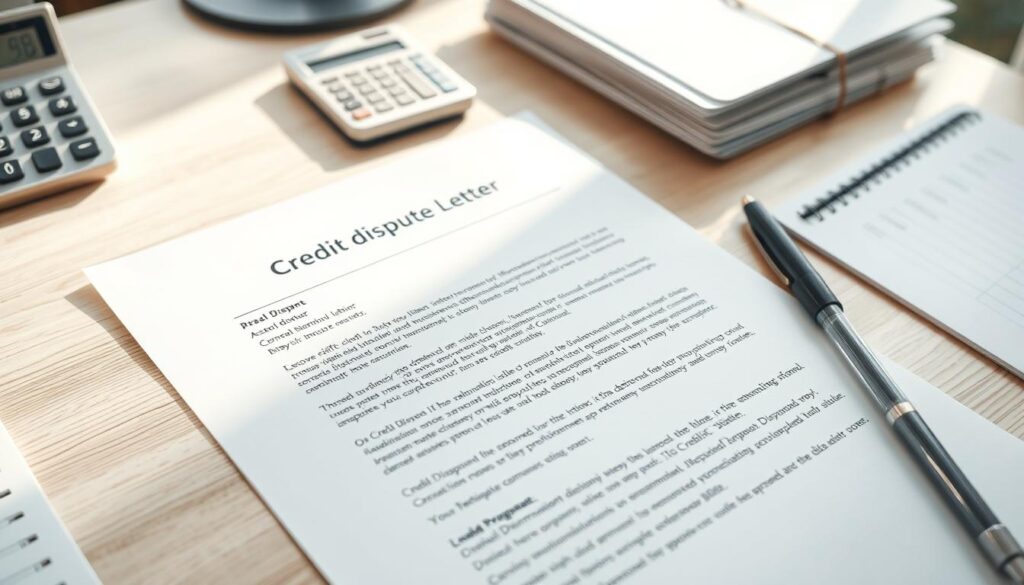A healthy credit score is vital for loans, renting, and job hunting. Errors on your credit report can harm your creditworthiness. You can dispute inaccuracies with credit bureaus to protect your score.
This guide will help you write an effective credit dispute letter. We’ll provide a template and share tips to improve your credit score.
Key Takeaways
- Understanding the importance of disputing credit report errors
- Gathering necessary information to prepare a credit dispute letter
- Identifying the key components of an effective credit dispute letter
- Utilizing a credit dispute letter template for a successful submission
- Implementing tips to write a compelling and persuasive credit dispute letter
Understanding Credit Disputes
Knowing your rights about credit report errors is vital. A credit dispute challenges wrong information on your credit report. Fixing credit report errors keeps your credit profile healthy and protects your finances.
What Is a Credit Dispute?
A credit dispute asks credit bureaus to fix credit report errors. These errors can include wrong personal info or fake accounts. Disputing credit report issues helps secure your financial future.
You can file disputes with Experian, Equifax, and TransUnion. They’ll investigate and correct any mistakes in your credit file.
Importance of Disputing Credit Report Errors
Wrong info on your credit report can hurt your consumer rights credit reports. Errors may lower your credit score, making it harder to get loans or jobs.
The credit dispute process helps fix these issues. It ensures your credit report shows your true financial history.
Accurate reports empower you to make smart money choices. They give you control over your financial well-being.
Regularly reviewing your credit report and disputing any errors is a crucial step in maintaining a healthy credit profile.
Preparing to Write a Credit Dispute Letter
Gathering information is key to disputing credit report errors. Identify specific issues on your report. This preparation helps craft a compelling letter to fix credit report mistakes.
Gathering Necessary Information
Get credit reports from Experian, Equifax, and TransUnion. Review each report for credit report errors or inaccuracies. Note items like late payments or incorrect account info to dispute.
Identifying Credit Report Errors
- Look for discrepancies in account information, payment history, or fraudulent activities.
- Pinpoint specific credit report errors to dispute. Gather supporting documents to validate your claims.
- Learn credit dispute best practices to write an effective letter.
Thorough review and preparation set the stage for a persuasive credit dispute letter. This attention to detail boosts your chances of success.
Your efforts can lead to fixing credit report mistakes and improving your credit profile. Remember, accuracy is crucial in this process.

how do i write a credit dispute letter
A credit dispute letter is vital for fixing errors on your credit report. It’s your official way to tell credit bureaus about problems you’ve found. A well-written letter boosts your chances of getting mistakes fixed.
Key Elements to Include
- Personal Information: Start the letter by providing your full name, current address, and contact details.
- Disputed Item Details: Clearly identify the specific item(s) you’re disputing on your credit report, including the account number, creditor name, and the nature of the error.
- Supporting Documentation: Gather and attach any relevant documentation, such as payment receipts, account statements, or correspondence with the creditor, to support your case.
Be brief but include all needed info to back up your dispute. This approach will help you create an informative and persuasive credit dispute letter.
Credit Dispute Letter Template
Using a credit dispute letter template can simplify the process. These templates offer a structure you can adapt to your specific needs.

A well-crafted credit dispute letter can greatly help fix errors on your credit report. It can also improve your overall financial health.
Components of an Effective Credit Dispute Letter
A well-crafted credit dispute letter is key to credit repair. Including specific elements can help your letter make a strong impact. Let’s explore the essential parts of a powerful dispute letter.
Personal Information
Start your letter with your full name, address, and contact details. This helps credit bureaus quickly identify you and your case. Clear information ensures your dispute gets to the right place.
Disputed Item Details
Clearly describe the items you’re disputing on your credit report. Include account numbers and creditor names. Explain why you think the information is wrong or incomplete.
Be as specific as possible in your credit dispute letter template. This approach strengthens your case and increases your chances of success.
Supporting Documentation
Include relevant documents to back up your claims. This might be copies of statements, receipts, or other proof. Label and organize all supporting documents clearly.
Make it easy for credit bureaus to review your case. Well-organized evidence can significantly boost your chances of a positive outcome.
These key components can improve your credit repair strategies. A strong dispute letter is a big step towards fixing your credit score.

Credit Dispute Letter Template
Writing a credit dispute letter can be challenging. A good template makes the process easier. It helps you include all necessary information and follow the proper format.
Use this credit dispute letter template as a guide:
- Date: Include the current date at the top of the letter.
- Recipient Information: Specify the name and address of the credit reporting agency or company you are disputing with, such as Equifax, Experian, or TransUnion.
- Subject Line: Clearly state the purpose of your letter, such as “Dispute of Inaccurate Information on Credit Report”.
- Introduction: Briefly explain the reason for your credit dispute, such as identifying an error in your credit report or challenging fraudulent activity.
- Disputed Item Details: Provide specific details about the item you are disputing, including the account number, the name of the creditor, the date the item appeared on your report, and a description of the error or inaccuracy.
- Supporting Documentation: List any relevant documentation or evidence you have that supports your dispute, such as payment receipts, account statements, or correspondence with the creditor.
- Requested Action: Clearly state the action you would like the credit reporting agency or company to take, such as removing the disputed item or correcting the information.
- Contact Information: Provide your full name, current address, and the best way to reach you, such as your phone number or email address.
- Signature: End the letter with your signature and a printed version of your name.
This template is a starting point. Adjust the content to fit your specific situation. Use it to create a well-organized and effective credit dispute letter.
A good letter will address all issues with your credit report. It will be comprehensive and help resolve any problems efficiently.

Tips for Writing a Compelling Credit Dispute Letter
An effective credit dispute letter needs careful attention and a clear approach. These tips will help you write a strong letter to improve your credit score.
Be Concise and Precise
Keep your credit dispute letter brief and focused. Stick to essential details and avoid long explanations. State the errors on your report clearly.
Outline the specific actions you want the credit bureau to take. This will help them understand your request better.
Provide Relevant Evidence
Gather and include documents that support your case. This strengthens your credit dispute significantly.
- Copies of bills, statements, or other records that contradict the information on your credit report
- Proof of identity theft or unauthorized accounts
- Correspondence with creditors or the credit bureau
Concrete evidence increases your chances of a successful dispute. It shows your commitment to improving your credit score.
Credit dispute best practices involve being thorough and organized. Follow these tips to address errors on your report effectively.
With persistence, you can take important steps towards credit repair strategies. Your well-written letter can make a big difference.
Sending the Credit Dispute Letter
Your credit dispute letter is ready. Now, it’s crucial to send it correctly. The dispute process can help protect your rights and keep credit reports accurate.
Choosing the right method to send your letter is important. It can increase your chances of success.
Choosing the Right Method
Consider these options when submitting your credit dispute letter:
- Mail: Send via certified mail with a return receipt. This gives you proof of delivery and creates a paper trail.
- Online Dispute: Many credit bureaus offer online portals. It’s convenient, but follow their instructions and keep submission records.
- Fax: Faxing provides transmission confirmation. Keep a copy of the fax cover sheet for your records.
Always keep thorough records during the dispute process. This strengthens your case and protects your rights if issues come up.
| Method | Advantages | Disadvantages |
|---|---|---|
|
| |
| Online Dispute |
|
|
| Fax |
|
|
Consider each method’s pros and cons carefully. This helps you choose the best way to submit your dispute letter.
A well-planned approach can boost your chances of success. Remember, protecting your consumer rights credit reports is key to a healthy financial future.
Following Up on Your Credit Dispute
Disputing credit report errors is just the start. The real work begins after submitting your dispute letter. Follow-up is crucial to ensure credit bureaus correct any mistakes.
Keep a close eye on your credit report after sending your letter. Credit bureaus must investigate and respond within 30 days. They’ll remove inaccurate information or leave accurate details on your report.
Don’t hesitate to take further action if you’re unsatisfied with their response. You can file a complaint with the Consumer Financial Protection Bureau (CFPB). You can also contact the Federal Trade Commission (FTC) for help.
Stay diligent and persistent to improve your credit report. A better credit score is vital for securing loans and credit cards. It also opens up more financial opportunities.

